By Marie-Claude Morice
In less than 10 years since the advent of the first percutaneous valvular prosthesis, transcatheter aortic valve implantation (TAVI) has emerged as a viable alternative to surgical aortic valve replacement for high-risk patients with severe aortic stenosis in whom conventional surgery may prove hazardous. The promising results achieved in recently reported randomised trials1,2 have prompted the use of this novel technique in a growing number of patients. However, while gender differences have been consistently explored in patients with coronary disease, the specific characteristics and outcome of women presenting with severe aortic stenosis have not been precisely outlined.
The influence of gender on the outcome of patients treated by aortic valve surgery has been analysed in only a small number of studies with dissimilar findings. Indeed, some studies have reported the female gender as being a predictor of perioperative or short-term mortality whilst others have shown better long-time survival in women or no sex-related differences at all.
Few data have been published on gender-specific outcome of patients undergoing TAVI despite the fact that women account for 50% of the population of elderly patients eligible for TAVI in contrast with percutaneous coronary intervention studies in which women represent only 15% to 20% of the patients enrolled in clinical studies.
In conducting the study recently published in JACC3, the authors sought to investigate the differences attributable to gender and identify significant sex-related characteristics in the clinical presentation and outcome of high-risk patients with aortic stenosis undergoing TAVI.
The authors also hypothesised that this novel interventional technique, if shown to be equally safe and effective in both genders, might prove all the more cost-effective in women as their life expectancy is longer.
A specific database was set up in which all patients undergoing TAVI with the Edwards valve and the CoreValve via the transfemoral, subclavian or transapical approach were prospectively included. The population of men and women were similar in size and all events were analysed in light of the new VARC criteria.
The results showed similar mean age in both sexes, but a lower rate of coronary and peripheral disease and previous cardiac surgery, higher left ventricular ejection fraction and lower Euroscore in female patients.
Successful device implantation was achieved in equal proportions in men as in women despite the anatomical characteristics of females (smaller body, femoral, aorta and aortic annulus size) and the use of small-size prostheses. Comparable haemodynamic performance was obtained in both sexes and post-TAVI residual mean aortic pressure gradient was similarly low in all patients at discharge.
Although conducted in a small number of patients (260 patients, of whom 131 were women), in a single centre at the early stage of implementation of this novel technology, this study highlighted significant gender-related differences in high-risk patients with severe aortic stenosis in whom TAVI was attempted with both of the currently commercialised valve prostheses.
While no significant relationship between gender and 30-day mortality was observed, women were characterised by a higher survival rate at one year compared to their male counterparts (76% vs. 65%, p=0.037) and male gender was identified as a predictor of mid-term mortality by cox regression analysis.
The benefit of TAVI in high-risk female patients could be further enhanced by the longer life expectancy associated with the female gender.
Marie-Claude Morice is an interventional cardiologist, Institut Cardiovasculaire Paris Sud, Massy, France
References
- Leon MB, Smith CR, Mack M et al. Transcatheter aortic valve implantation for aortic stenosis in patients who cannot undergo surgery. N Engl J Med 2010;363:1597–607
- Smith CR, Leon MB, Mack MJ et al. Transcatheter versus surgical aortic valve replacement in high-risk patients. N Engl J Med 2011;364:2187–98
- Hayashida K, Morice MC, Chevalier B et al. Sex-related differences in clinical presentation and outcome of transcatheter aortic valve implantation for severe aortic stenosis. 2012;59:566–571










